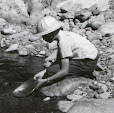 |
| From Washington Geological Survey, Bulletin No. 1, Geology and Ore Deposits of Republic Mining District, 1910. |
Over the years, beginning in about 1910, several agencies—including the Washington Geological Survey and the USGS—published a variety of reports describing the mines, minerals, and geology of different localities in the state of Washington. These long-out-of-print booklets contain a wealth of information about the various minerals found in the state and the mining operations that worked to extract them.
Thanks to the Washington State Library, many of these works have been digitized and are available on the library's website. Access is free and the documents can be downloaded as PDFs, enabling one to build a collection of this information.
In addition, most of these publications contain a bibliography listing related works that may be worth searching for.
Searching the Washington State Library is easy:
1. Navigate to the library's website at https://www.sos.wa.gov/library/catalog.aspx.
2. Select "Title" in the "Search By:" drop-down box and type a few likely title words in the "Search Words:" box. Then select "Digital Collection" in the "Search In:" section under "Additional Options."
3. Click on the blue "Search" button to the right of your "Search Words" entry.
4. Click on one of the titles displayed in the search results.
5. On the page that loads, click on "View online from Washington State Library" to access the document.
On this page, you will have the option to read the document, download it as a PDF, or print a copy of it.
You can also search by keywords which usually turns up a large selection of documents. Sometimes, you will see a listing like the one below with a link titled, "Website." Clicking on this link will usually take you to a PDF of the selected item.
The publications available from the Washington State Library will allow you to learn a great deal about the history of mining in Washington (and in other locations as well). In addition, you will find information about locations and occurrences for a large variety of minerals as well as details about the mining operations that recovered them.
WARNING: Should you decide to visit any of the old mines or prospects described in this literature, be sure you have permission to visit the property if it is under private ownership, as many of them are. Also, DO NOT ENTER MINE WORKINGS! They are extremely dangerous places. The hazards are too numerous to list but include cave-ins, sharp objects, toxic gases, corrosive waters, wild animals, and vertical shafts, the openings to which can be in the floor of the tunnel and, hidden under debris, could send you plunging straight down for several hundred feet and going "splat" at the bottom. STAY OUT!
To assist you on future visits to the WSM blog, the link to the Washington State Library search page has been added to the right-hand sidebar under "Prospecting Aids."
Have fun and be safe.







